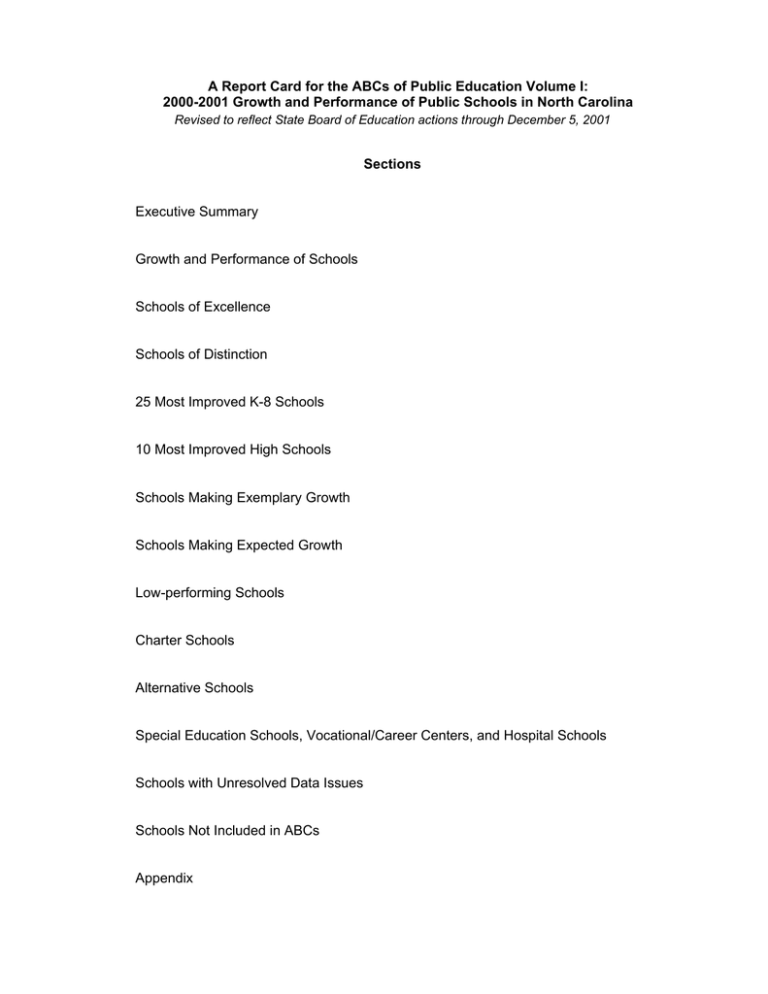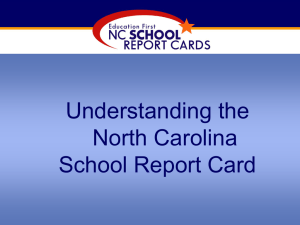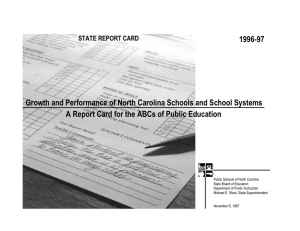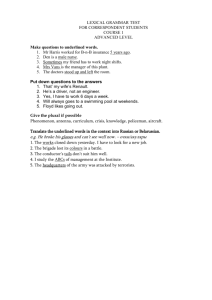A Report Card for the ABCs of Public Education Volume... 2000-2001 Growth and Performance of Public Schools in North Carolina
advertisement

A Report Card for the ABCs of Public Education Volume I: 2000-2001 Growth and Performance of Public Schools in North Carolina Revised to reflect State Board of Education actions through December 5, 2001 Sections Executive Summary Growth and Performance of Schools Schools of Excellence Schools of Distinction 25 Most Improved K-8 Schools 10 Most Improved High Schools Schools Making Exemplary Growth Schools Making Expected Growth Low-performing Schools Charter Schools Alternative Schools Special Education Schools, Vocational/Career Centers, and Hospital Schools Schools with Unresolved Data Issues Schools Not Included in ABCs Appendix A Report Card for the ABCs of Public Education Volume I: 2000 - 2001 Growth and Performance of Public Schools in North Carolina Key to Status Abbreviations, Codes Used in ABCs Report Status Abbreviations Exc Dst MI MI Exm Exp NR LP EE 98R 95R School of Excellence School of Distinction 25 Most Improved K-8 Schools 10 Most Improved High Schools School Making Exemplary Growth School Making Expected Growth School Receiving No Recognition Low-Performing Excessive Exclusions Less than 98 percent tested Less than 95 percent tested Special Codes 1 2 3 9 K-2 feeder school Senior high school – grades 9-12 option Senior high school - grades 10-12 option School did not meet data requirements * Confidence interval applied ii A Report Card for the ABCs of Public Education Volume I: 2000 - 2001 Growth and Performance of Public Schools in North Carolina Reflects changes approved by SBE on December 5, 2001 Executive Summary Background The State Board of Education (SBE) developed the ABCs of Public Education in response to the School-Based Management and Accountability Program enacted by the General Assembly in June 1996. The ABCs focuses on: strong accountability with an emphasis on high educational standards; teaching the basics; and maximum local control. The first ABCs accountability model was implemented in elementary and middle schools in 1996-97. A high school accountability model was developed during 1996-97, and was implemented for the first time in 1997-98. In 1998-99 the two models were combined into one comprehensive ABCs model for elementary, middle and high schools. In 19992000 this model was implemented again, augmented by a new policy for participation of alternative schools. Additionally, the 1999-2000 accountability year was the first year of reporting ABCs results for schools that are administered by the Department of Health and Human Services and the Department of Juvenile Justice and Delinquency Prevention. In the 2000-2001 school year, the ABCs accountability model was fine-tuned in response to input from schools and school districts, actions of the SBE, and experience with previous years’ ABCs. Modifications included the following: a) implementing End-of-Course (EOC) prediction formulas for the 10 multiple choice EOC tests; b) including ABCs dropout rates in the growth composite for high schools; c) adding Computer Skills test results at grade 8 to the performance composite; d) adding Alternate Assessment Portfolio results to the performance composite; e) removing Writing at grades 4 and 7 from the growth composite (but they remain a part of the performance composite); f) weighting the growth composite; g) and, using the results of an equating study (described below) to include new mathematics test results in the ABCs (both growth and performance). The ABCs accountability program sets growth and performance standards for each elementary, middle, and high school in the state. End-of-grade (EOG) and EOC test results and selected other components are used to measure the schools’ growth and performance. Schools that attain the standards are eligible for incentive awards or other recognition (including Schools of Excellence, Schools of Distinction, 25 Most Improved K-8 Schools or 10 Most Improved High Schools in Academic Growth). To be eligible for incentive awards, schools also must not have excessive exclusions from testing and must test at least 98% of their eligible students in K-8, and at least 95% of students enrolled in specific courses or grades in high school. Schools where growth and performance fall below specified levels are designated as low-performing. iii 2000-2001 Mathematics Tests Equating Study In May of 1998, the State Board of Education (SBE) adopted a new K-12 mathematics curriculum. A transitional curriculum was implemented in 1999-2000 involving the teaching of the old and new mathematics curricula to accommodate both operational testing and the development of new mathematics tests. Using the mathematics field test data from spring 2000, the new (2nd Edition) mathematics tests were assembled and were administered for the first time in the spring of 2001. In the ABCs, growth is calculated from year to year. So it was necessary to conduct a special equating study during the summer 2001 to be able to convert the 2nd edition mathematics scale scores to equivalent scores on the old mathematics scale. Once the two series of tests were equated, the existing ABCs growth formulas could continue to be used for the 2000-01 ABCs. This same study was used to create revised achievement levels for the EOG mathematics tests. (Interim achievement levels set earlier based on the 2000 field test data turned out to be too low for use with the ABCs. See Achievement Levels in the appendix.) Two groups of analysts worked independently conducting equating studies during the summer of 2001 for the EOG mathematics tests. “Equipercentile” equating was used. In this method, the percentiles of each score distribution (i.e., for the old and new mathematics tests) are calculated and scores that correspond to the same percentile ranks are equated. (See 2000-2001 Equating Study Results Grade 3 Mathematics in the appendix). Because interim achievement levels were set too low, on May 24, 2001, the SBE formed an Ad Hoc Committee to take immediate actions to audit the NC Testing and Accountability Program. A panel of technical experts with advice from the Southern Regional Education Board (SREB) worked with the ad hoc committee to oversee the audit process. After reviewing the equating process for the old and new mathematics tests, reviewing the process used to field test and set cut scores, and reviewing the process used to calculate ABCs school performance, it was determined on September 7, 2001 that the technical process being used to compute school-by-school performance for the ABCs was sound. The ad hoc committee of the SBE accepted the report and directed the Department of Public Instruction to proceed with ABCs reporting. With this approval, the 2nd edition mathematics scores were converted onto the old mathematics scale and the existing ABCs growth formulas were used to calculate ABCs status (with minor modification of the growth model for fall to spring growth in the third grade, because both pre and post scores in third grade were on the new mathematics scale.) Similarly, the revised achievement levels based on the equating study were used to compute performance composites for the 2000-01 ABCs. Participating schools In 2000-2001, every school that contained one or more of the grades 3-12 and that submitted the appropriate data participated in the ABCs. K-8 schools’ data include test results in reading, mathematics, writing in grades 4 and 7, Computer Skills at grade 8, Alternate Assessment Portfolio and EOC tests if the subject(s) are taught in the school. High schools’ data include EOC test results, North Carolina High School Comprehensive Test results (NCHSCT), Alternate Assessment Portfolio, percent of students completing iv College University Prep/College Tech Prep courses of study, change in ABCs dropout rates, and change in competency passing rates. K-2 schools sending more than half of their students to a single receiving school were eligible for incentive awards if the receiving school earned an incentive award based on making its growth standard. Alternative schools followed a special plan of inclusion in the ABCs in 2000-2001. Accountability in these schools was based on achievement data (EOC, EOG, NCHSCT, competency passing rates) and on three locally selected accountability measures. These “local options” were selected objectives that were specified on school improvement plans and approved by the local boards of education. The status and incentive awards for alternative schools were determined using the criteria specified in State Board of Education Policy HSP-C-013. Results are reported here in a special section for alternative schools. Special education schools, vocational/career centers and hospital schools were considered for incentive awards based on the performance of the schools they served. They received prorated incentive awards on this basis. These schools appear in a special section of the report. Analyses The status of schools and incentive awards were determined by the values of three weighted composite scores in the ABCs. They are the expected growth composite, the exemplary growth composite, and the performance composite. These composite scores consisted of many components, depending on the grade span and curriculum of the school, as follows. Expected growth composites include as many of the following as apply in a given school: growth in EOG reading and mathematics for grades K-8 and grade 10 based on three factors: statewide average growth, the previous performance of students in the school, and a statistical adjustment which is needed whenever test scores of the same students are compared from one year to the next, growth in high school EOC performance based on EOC prediction formulas change, or gain over a two-year baseline in English II, change over a two-year baseline in the percent of students completing college university prep/college tech prep courses of study, change from grade 8 to grade 10 in the competency passing rate, change in ABCs dropout rates from 1998-99 to 1999-2000. Exemplary growth composites include as many of the above as apply in a given school. However, the exemplary standard factors in an additional ten percent above the statewide average growth for grades 3-8 and 10, and an additional 3% above the statewide average used in the EOC prediction formulas. For English II, the exemplary growth standard requires an additional 5% over the baseline for expected growth. There is no exemplary growth standard for the competency passing rate, the change in the percent of college university prep/college tech prep completers or the change in ABCs Dropout rate. v The performance composite is based on the percentage of scores at Achievement Level III or above in reading, mathematics, writing in grades 4-7, North Carolina Alternate Assessment Portfolio (NCAAP), Computer Skills Test at grade 8, and specific courses and grades in high schools. Student test scores in Algebra I and II, Biology, Chemistry, English I and II, ELPS, Geometry, Physical Science, Physics, U.S. History, and the High School Comprehensive Test are included in the performance composite. The Algebra I scores of ninth graders who took Algebra I prior to ninth grade are included in the high school’s performance composite. (See Technical Notes in the Appendix for an explanation of how scores are handled in senior high schools and how the NCAAP scores are calculated). The ABCs results published here were produced on a Compaq Deskpro EN computer, Model ENC/P1.0/20e/6/256cvn, Pentium III processor with 261 MB RAM running under Microsoft Windows 2000 Vs. 5.002195. Additional detail and technical information about ABCs analyses are provided in the Appendix. Definition of Awards and Recognition Categories Schools were classified into several categories for the purpose of awarding incentives and recognition. The award or recognition a school receives is determined in most cases by the school’s attainment as reflected in the growth composites (expected and exemplary) and the performance composite. (Exceptions include K-2 feeder schools, alternative schools, and special schools). The categories are defined as follows. Schools of Excellence A School of Excellence is a school that made expected growth and had at least 90 percent of its students’ scores at or above Achievement Level III. Such schools will receive a dated banner to hang in the school and a certificate. In addition, they will receive whatever incentive award they earn as having made expected or exemplary growth. Schools of Distinction A School of Distinction is a school that had at least 80 percent of its students performing at or above Achievement Level III irrespective of growth (but does not qualify as a School of Excellence). Schools of Distinction will receive a plaque and a certificate. 25/10 Most Improved Schools in Academic Growth The 25 Most Improved K-8 schools are those that attained the State’s 25 highest values on the exemplary growth composite. The 10 Most Improved High Schools attained the State’s 10 highest values on the exemplary growth composite. (Any school with a combination of grades which includes grade 9 or higher was eligible for the high school recognition rather than the K-8.) These schools will receive a dated banner to hang in the school, a certificate and financial awards. Schools Making Exemplary Growth These schools attained their exemplary growth standard. They will receive a certificate and incentive awards. Incentive awards for making exemplary growth are $1500 per person for certified staff and $500 per person for teacher assistants. vi Schools Making Expected Growth These schools attained their expected growth standard (but not their exemplary growth standard). They will receive a certificate of recognition and financial awards. Incentive awards for making expected growth are $750 per person for certified staff and $375 per person for teacher assistants. Schools with No Recognition These schools did not make their expected growth standards; but they have at least half their students scoring at or above Achievement Level III as measured by the performance composite. Low-Performing Schools Low-Performing Schools are those that fail to meet their expected growth standard and have significantly less than 50% of their students performing at or above Achievement Level III. In addition to the growth and performance standards, there are testing requirements that all schools must meet. K-8 schools must test at least 98% of their eligible students. High schools must test at least 95% of all students enrolled in courses/grades for which EOC tests or the NCHSCT are given respectively. In this report, schools that violate testing requirements are assigned a violation status and cannot receive another ABCs status, except low-performing. The low-performing schools that violate testing requirements are assigned the low-performing status in addition to the violation status. Schools that violate any of the testing requirements are not eligible for financial awards. In addition, the State Board of Education may designate schools that violate testing requirements for two consecutive years as low-performing. Presentation of Results The results are presented in A Report Card for the ABCs of Public Education Volume I: 2000-2001 Growth and Performance of Public Schools in North Carolina. The first section of this report, Growth and Performance of Schools presents the growth and performance of all non-alternative schools in North Carolina participating in the ABCs. Other sections, Schools of Excellence, Schools of Distinction, 25 Most Improved K-8 Schools, 10 Most Improved High Schools, Schools Making Exemplary Growth, Schools Making Expected Growth, and Low-Performing Schools, follow. Charter Schools with sufficient data to participate in the ABCs appear in the previous sections where appropriate and are also included in a separate section, Charter Schools, for easy reference. Alternative schools appear only in a section designated Alternative Schools. Special education schools, vocational/career centers, and hospital schools also appear in a special section of the report. Schools that were unable to submit complete data before the processing deadlines are included in a section called Schools with Unresolved Data Issues. In sections of the report where appropriate, a status column indicates each school’s ABCs status or failure to meet testing requirements. North vii Carolina public schools that are not included in the ABCs because of data requirements are listed in the final section, Schools Not Included. The Appendix includes an explanation of adjustments for special ABCs conditions, a summary of standard conventions used in the ABCs analyses in Technical Notes, a table of the values, called Constants and Parameters, used in the ABCs growth formula computations, an example of how the Alternate Assessment Portfolio results were incorporated into the performance composites, and the achievement levels and score conversions derived from the equating study. Statistical Summary of Results In the 2000-2001 implementation of the ABCs, 2156 public schools were assigned an ABCs status. These included traditional public schools spanning combinations of grades K-12; charter schools; alternative schools; and certain K-2 schools (those that fed more than 50% of their students into a single receiving school in 2000-2001). There were 30 special education, vocational/career centers and hospital schools that were not assigned an ABCs status, but participated on the basis of the schools that they served, as explained above. Schools that violated testing requirements were assigned a violation status and did not receive another ABCs status, except low-performing. There were three schools that violated testing requirements. None of them was assigned an ABCs status. Fourteen schools were not included in the ABCs because they failed to meet data requirements. The results for schools that were assigned a status appear below. ABCs Results for All Schools Award or Recognition Category Number of Schools K-12 Alt. Total % Schools Making Exemplary Growth Schools Making Expected (not Exemplary) Growth Schools Receiving No Recognition Low-performing Schools 95R, No Status 504 720 833 30 2 17 51 0 1 1 521 771 833 31 3 24.1 35.7 38.6 1.4 0.1 Total ABCs Schools 2089 70 2159 99.9 Note. Percents may not add to 100% due to rounding. viii In addition, the following numbers of schools received special recognition. (These categories may overlap categories in the above table.) Schools Receiving Other Recognition Category Number of Schools Percent of Schools 171 640 25 10 7.9 29.7 1.2 0.5 Schools of Excellence Schools of Distinction 25 Most Improved K-8 Schools 10 Most Improved High Schools Overall, 59.9% of the public schools made either expected or exemplary growth standards under the 2000-2001 ABCs Accountability model. ix








